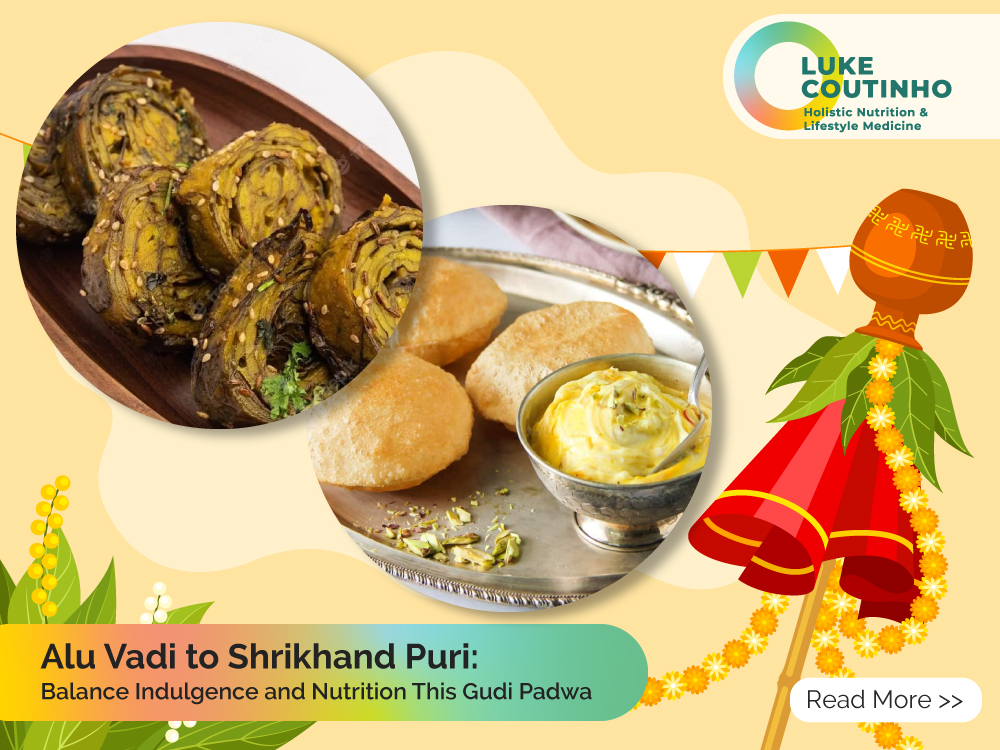
Alu Vadi – A Savoury Festive Treat
Alu leaf is called colocasia in English. It is also known as arbi ke patte (patte translates to leaf) or taro leaf rolls. Alu Vadi, a famous Maharashtrian recipe, refers to steamed dumplings mostly made with chickpea flour or besan with a blend of fresh spices. Patra in Gujarat is a slightly sweeter version of the alu vadi with the addition of jaggery. The process is more or less the same. Learn the art of making traditional Maharashtrian alu vadi and reap its surprising health benefits.
Ingredients
- 6 large fresh colocasia leaves, arbi/taro leaves
- ¾ cup chick pea flour, besan
- ¼ cup rice flour
- ¼ cup sattu flour
- ½ tsp turmeric powder
- ½ tsp ground pepper powder
- 2 tsp ground Sri Lankan cinnamon
- ¼ tsp bishop's weed, ajwain
- 1 tsp ground fennel seeds, saunf
- 1 tsp chili powder
- ½ tsp ground cumin seeds, jeera
- 1 ½ tsp salt
- 1- inch ginger, peeled and grated (adrak)
- 2 green chilies, optional
- 5 tbsp fresh tamarind pulp
- ½ cup jaggery powder
- 500 ml water
For the tempering:
- 1 tbsp cold-pressed coconut oil or unrefined mustard oil
- 2 tsp mustard seeds, rai
- 1 tsp asafoetida, hing
- 2 tbsp sesame seeds, til
- 10 - 12 curry leaves
- 2 tbsp fresh coriander leaves to garnish
Instructions
To prepare the colocasia leaves:
- Begin by wiping the colocasia leaves.
- Clean them with a damp kitchen towel.
- Clean both sides thoroughly.
- Use a knife to trim the thick spine that runs down the leaf.
- Run the knife across the stalk to flatten it.
- Repeat the trimming for all the leaves.
To make the batter:
- In a large bowl, combine the chickpea flour, rice flour, sattu flour, ground cinnamon, ajwain, ground fennel seeds, ground cumin seeds, chili powder, and salt.
- Whisk to combine.
- Add the grated ginger, green chili paste, tamarind, and jaggery powder next.
- Slowly add the water, mixing it well to ensure a smooth paste is formed without any lumps.
- Set aside for 15 minutes.
To assemble the alu vadi:
- Arrange the colocasia leaves by size, beginning with the largest to the smallest leaf.
- Take the largest colocasia leaf and lay it out on a clean surface.
- Top with a large spoonful of batter.
- Use a clean spoon or your hands to spread the batter over the leaf.
- Take the second largest leaf and place it opposite to the first leaf.
- Repeat the process for the other leaves.
- Once all the leaves are heaped on top of each other, cover it finally with more batter.
- Fold one side of the leaves down and bring it to the center and repeat for the other side to ensure the leaves meet in the middle.
- It should form a rectangle.
- Cover with more batter.
- Starting from the short side, start rolling it into a log that is tight enough without the batter squeezing out.
- Once done, apply the remaining batter to coat the roll outside and stick down the loose ends.
- To steam the alu vadi
- Grease a dish with a few drops of oil and place it in the steamer/pressure cooker (don't use the whistle).
- Place the rolls on the dish with the sealed side facing down.
- Close the lid and steam on medium heat for 20 minutes.
- Let it cool down. Cut the roll into wide pieces.
To finish the alu vadi:
- Slice the cooled alu vadi into thin slices.
- You can eat them steamed or fry them too as per suitability.
For the tempering:
- Heat oil in a pan.
- Add the mustard seeds. Once they splutter, add asafoetida, sesame seeds, and curry leaves.
- Add the alu vadi slices to the pan and cook on both sides until golden brown and crispy.
- Garnish with fresh coriander leaves.
- Serve hot.
Power tips and variations:
- The most common problem with alu leaves, especially if they are not tender or fresh, is that it causes itching in the throat. Hence, a souring agent is added to the recipe to combat this. In this case, tamarind pulp is added.
- Pick out the leaves carefully. The leaves should be green, without any spots (turn back to check for any pest infestation, while buying).
- You can use spinach leaves also if colocasia leaves are unavailable.
- You can use grated coconut for garnish too.
Notes
- Taro leaves are rich in vitamins B, C, thiamine, riboflavin, folate, manganese, copper, and potassium which boost the brain and the nervous system.
They are rich in iron, Vitamin A and contain omega 3 too. An important amino acid arginine is present in them which helps in maintaining overall reproductive health.
Nutrition
Calories: 120kcalCarbohydrates: 18gProtein: 4.3gFat: 2.5g
Tried this recipe?Tag us on instagram with some pictures!